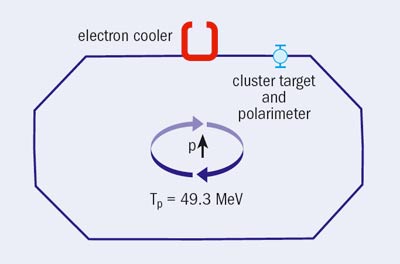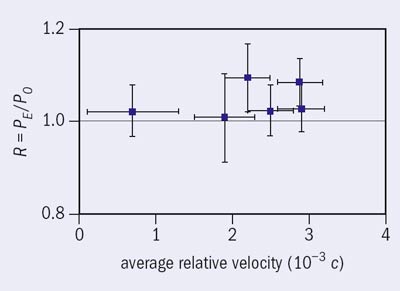
The QCD physics potential of experiments with high-energy polarized antiprotons is enormous, but until now high-luminosity experiments have been impossible. This situation would change dramatically with the production of a stored beam of polarized antiprotons, and the realization of a double-polarized high-luminosity antiproton–proton collider. Recent measurements at the Cooler Synchrotron (COSY) at Jülich have for the first time studied the influence of unpolarized electrons on polarized protons, settling a puzzle over the magnitude of such effects.
The collaboration for Polarized Antiproton Experiments (PAX) has proposed a physics programme that would be possible with a double-polarized proton–antiproton collider at the new Facility for Antiproton and Ion Research (FAIR), which is to be built at GSI in Darmstadt (PAX Collaboration 2006). The original idea was to use polarized electrons to produce a polarized beam of antiprotons (Rathmann et al. 2005). This triggered further theoretical work on the subject and a group from Mainz proposed using co-moving electrons or positrons (e) at slightly different velocities from the orbiting protons or antiprotons (p) as a means to polarize the stored beam (Walcher et al. 2007). When the relative velocities, v, between the e and p are adjusted so that v/c is about 0.002, a numerical calculation by the Mainz group predicts the cross-section for the ep spin-flip to be as large as about 2 × 1013 b. Analytical predictions for the same quantity by a group from Novosibirsk, however, yield a range well below one millibarn (Milstein et al. 2008).

To provide an experimental answer to the puzzle, the collaborations for PAX and for the Apparatus for Studies of Nucleon and Kaon Ejectiles experiment joined forces at COSY, where they mounted an experiment that used the electrons in the electron cooler as a target and measured the effect of the electrons on the polarization of a 49.3 MeV proton beam orbiting in COSY. Instead of studying the build-up of polarization in an unpolarized beam, the teams studied the inverse by observing the depolarization of an initially (vertically) polarized beam; they measured the proton-beam polarization using the analysing power of proton–deuteron elastic scattering on a deuterium cluster jet target (figure 1).
Figure 2 shows the results, with the ratio of the measured beam polarizations, PE and P0 (Oellers et al. 2009). PE represents the measured polarization corresponding to well defined changes of the electron velocity with respect to the protons. This was achieved by detuning the accelerating voltage in the electron cooler by a specific amount compared to the nominal voltage. P0 is the polarization measured when the electron beam was off (i.e. no electron target was present). No depolarization effect on the proton beam could be detected within the statistical precision of the measurement. This translates into an upper limit for the ep transverse and longitudinal spin-flip cross-sections of 1.5 × 107 b at a relative velocity of v = 0.002, six orders of magnitude below the numerical predictions. After the completion of the experiment, the Mainz group uncovered a numerical overestimation in their original estimates (Walcher et al. 2009).
The result rules out the practical use of polarized leptons to polarize a beam of antiprotons with present-day technologies. This leaves spin-filtering as the only proven method to polarize a stored beam in situ, a technique that exploits the spin- dependence of the strong interaction using a polarized internal target (Rathmann et al. 1993). At present, a complete quantitative understanding of all underlying processes is lacking, so the PAX collaboration aims to use stored protons in COSY for high-precision polarization build-up studies with transverse and longitudinal polarization. Under these circumstances, the build-up process itself can be studied in detail because the spin-dependence of the proton–proton interaction around 50 MeV is completely known. The internal polarized target and the target polarimeter required for these investigations are currently set up to be installed together with a large-acceptance detector system for the determination of the beam polarization in a dedicated low-β section at COSY.
In contrast to the proton–proton system, the experimental basis for predicting the polarization build-up by spin filtering in a stored antiproton beam is practically non-existent. Therefore, it is of high priority to perform a series of dedicated spin- filtering experiments using stored antiprotons. The Antiproton Decelerator at CERN is a unique facility at which stored antiprotons in the appropriate energy range are available with characteristics that meet the requirements for the first-ever antiproton polarization build-up studies.
Further reading
I Milstein et al. 2008 Nucl. Instrum. Meth. B 266 3453.
D Oellers et al. http://arxiv.org/abs/0902.1423.
PAX Collaboration 2006 Technical Proposal for Antiproton–Proton Scattering
Experiments with Polarization, www.fz-juelich.de/ikp/pax.
F Rathmann et al. 1993 Phys. Rev. Lett. 71 1379.
F Rathmann et al. 2005 Phys. Rev. Lett. 94 014801.
T Walcher et al. 2007 Eur. Phys. J. A 34 447.
T Walcher et al. 2009 Eur. Phys. J. A 39 137.





